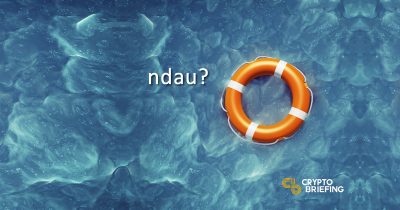ndau Claims Solution To Stablecoins' 'Massive Flaws'

Share this article
Stablecoins are the ‘in’ thing at the moment. Prices have been on an almost continuous downward trend since the start of the year, with the market now worth less than a quarter of what it was back in January. Dreams for a trillion-dollar crypto market have turned sour. It’s time for something new.
Downward trends have the sector worried. Many blockchain businesses have significant holdings in cryptocurrency: bear markets shrink the volume of spare capital available for improving their own businesses or investing into other projects.
Tether (USDT) often sees a marked increase in trading volume during bearish trends. When the SEC rejected the Winklevoss’ ETF approval, the amount of Tether bought on exchanges increased by over 300%.
Investors move into stablecoin positions to maintain a steady store of value, but the fact that there has only ever been one third-party snapshot on Tether’s holdings has investors worried. Investing in Tether is a risky business: the game could be up at any moment.
The problem with stablecoins
This week began with two companies unveiling their new stablecoins. New York-based firms, Paxos and Gemini (the exchange owned by the Winklevoss twins), announced the release of tokens; both backed 1:1 to the US dollar; both approved by New York regulators.
These have attracted a lot of attention from the community. Audited accounts by recognized names mean the sector has a product pegged to a real-world asset.
But does it need it?
“As a VC fund, we’re looking to invest in technologies with growth potential”, says Ciaran Hynes, Managing Partner of the Irish venture capital fund, COSIMO Ventures. “Stablecoins have massive flaws and we don’t see much use, or any point, to them”.
Speaking from Boston’s Token Fest blockchain conference, Hynes explains that the main issue with stablecoins pegged to fiat currencies, like the dollar, is most will not maintain a stable store of value. As the USD depreciates in value by around 2% every year, investors’ positions in dollar-backed coins will fall by the same margin. This publication has voiced similar concerns, especially about the Gemini stablecoin.
“Stablecoins simply won’t beat inflation”, says Hynes. “You could put your money in gold instead, but the asset is still affected by market fluctuations and you lose out on the easy transfer afforded by tokenization.”
ndau: an alternative.
COSIMO Ventures instead looked into tokenized alternatives that can maintain a stable store of value by relying on other mechanisms. For the last year, they have been the principal investor in a project called ndau, a ‘buoyant’ cryptocurrency that self-regulates and independently checks its own price through digital controls, governance, and a monetary supply.
“Stablecoins can work if you’re only holding your value in there for a short period of time,” says Ken Lang, COSIMO’s CTO and an early supporter of ndau. “But longer-term the value is guaranteed to decline because of inflation; being buoyant essentially means ndau is stable on market downsides and good on the increases”,
ndau uses two key incentives for maintaining a steady price. When investors buy ndau tokens, the net proceeds go into a reserve fund. Although ndau tokens initially went for $1, the net proceeds have increased as the token price rises as more are sold, up to $16,000. When the market price starts to decline, the reserve buys up tokens at a floor price that stops the price from falling too far. “There’s no bottom price for bitcoin or ether, meaning they could theoretically go to zero tomorrow”, says Lang. “This mechanism means ndau has some sort of minimum value”,
Lang explains that the project also uses a mechanism which they call the ‘stabilisation of incentive’ that incentivizes its holders to maintain their long-term positions, whilst penalizing those who sell during bearish trends. An additional fee, paid in ndau tokens, is introduced when the market price drops, which is subsequently burnt.
For Lang this has two key effects. It disincentives sell-offs and prevents panic selling during downward trends; secondly, it encourages the long-term holders to keep hold of their assets. “ndau tokens that are burnt mean the total supply shrinks, a shrinking supply leads to a rising market price,” he says. “Those who decide not to sell are actually rewarded with an increase in value”.
ICO projects are already interested.
Developed by the Boston-based team Oneiro, ndau has been in ‘stealth mode’ for the last year but has still attracted a lot of interest. The ongoing private sale has attracted $15m so far, with the net proceeds going into the reserve.
Hynes explains that many ICO projects, which principally have their holdings in ETH, have been very enthusiastic; however, family offices, high net-worth individuals and institutions have also expressed an interest in ndau.
Hynes and Lang emphasize that the project still remains true to the principles of decentralization. Built on its own blockchain, ndau’s governance structure is set to have a Blockchain Policy Council (BPC), comprised of nine members, that provide new policies for the project. Members are elected by, and from, ndau token holders.
“The governance is designed for ndau to evolve”, says Lang. “More data and expertise overtime mean policy might need adapting; having an elected and accountable BPC ensures ndau is always improving.”
Depending on who you talk to, volatility is either the best or worst thing about cryptocurrency. Although great for speculators, assets with different price behaviors will be needed as the space matures.
Both Hynes and Lang see buoyancy coins as a class of crypto with a strong future ahead of them. Somewhat similar to what Tron is doing, ndau mitigates volatility through monetary controls.
There is no guarantee that pegging to another asset will ensure a stable price. Price mechanisms, like the one used by ndau, may not be the complete answer for long-term stability, but they’re closer.
That’s something to be buoyant about.
The author is invested in BTC and ETH, which are mentioned in this article.
Share this article
